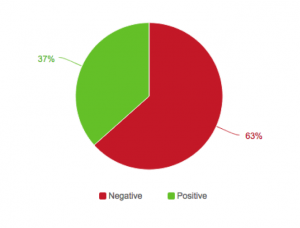In the third installment of Marketing Land’s tag management series, contributor Domenico Tassone explains how and why marketers must be involved in choosing a TMS.

You’ve probably read multiple tag management 101 articles by now, including Part 1 and Part 2 in this ongoing series (if not, please check them out). This article is going to take it to the next level and it may even be a bit of a left turn for many readers.
First, to be clear, the people in charge of website analytics should still be stakeholders in tag management decision-making. This is an important role for tag management and probably the most important one. However, it is really the tip of the iceberg, and focusing too tightly on website analytics has hindered bigger-picture thinking.
The real opportunity for digital marketers today is how they can leverage tag management into third-party technology interoperability and data transport. It may sound techie, but it has a serious impact on what digital marketers are able to accomplish every day. (Disclosure: I am an advisor to Signal, which offers TMS services.)
Site Analytics Bias In Tag Management Sabotages Digital Marketers
All too often, the approach to tag management is one-dimensional, dominated by IT and site analytics concerns, and marketing gets short shrift. Perhaps this is because vendors have successfully targeted the departments that bear the obvious and immediate brunt of tag management demands. Often, they are asked to fight raging fires with water balloons: little or no tag management tools and processes.
However, approaching a tag management solution with a web-site-analytics-only mentality means the decision-maker will likely end up with a consideration set of a handful of platforms that largely do the same thing and work the same way. Sometimes, these platforms are expedient or even offered for free. More often than not, these tools are usually weaker products that are all about site analytics platform lock-in and/or are acting as Trojan Horses for a different business model.
The problem with the site-analytics-only approach is that because implementing a tag management system is costly and invasive, choosing the wrong system can be a serious limiter for digital marketers once the solution is in place. Additionally, a site-analytics-only orientation reinforces pernicious organizational silos that can create or worsen strain on the digital marketing teams that are responsible for managing tags and associated site behavioral data for their campaigns.
Tag Management Leftovers For Digital Marketers?
For too many digital marketers, the end result of this unfortunate focus is that they are left with little or no say in the tag management decision, and they often don’t have any involvement with it once it’s adopted. As a result of this, many have come to rely on their digital agencies to deal with the logistics of media-related site tagging.
In most cases, this is done using a display ad server container tag, which was originally developed for view-through analytics purposes – not tag management.

The inconvenient reality is that that legacy ad server containers are still remarkably primitive and, worse, the agency ad operations staff managing them tend to be entry-level with high churn.
While they allow media agencies the convenience of bypassing IT for simple tag deployment, the basic technical piggybacking method used by these containers still consumes the user’s web browser resources. Additionally, because of junior staff members’ limited skill set, they rarely appreciate the need for transparency to the client on third-party data-sharing and may or may not check for JavaScript errors.
To make matters worse, because this process is treated largely as an afterthought, tags might get added but are rarely removed. That means they tend to have a cumulative effect that increases user latency (especially if piggybacking) and also leaks valuable behavioral data, i.e., sending data to ad networks unrelated to any current campaigns.
Both the quantity and quality of agency ad server tags are problematic. From a quantity standpoint, there are usually out-of-date agency ad server tags all over the site from several agencies ago… many are even on the conversion path. In terms of quality, site engineers typically had little to no interaction with agency ad ops or vendor engineering to enable them to test or resolve JS tracking tags that were throwing errors.
Case-Study: Flying Blind
In one of my prior career lives, this all came to a head. A large retailer with a significant e-commerce business struggled to manage a vast cornucopia of site tags from digital agency ad servers, ad networks, analytics tools, research services and more. Meanwhile, the performance engineering team had no tolerance for the latency that all browser-side JavaScript tags caused on the user’s computer, plus there was always the risk of errors.

In order to prevent problems from digital marketing tag proliferation during the pivotal holiday season, the initial solution was to take them all down from mid-October to mid-January. That’s right, with the exception of site analytics tracking tags, all digital marketing tags were deprecated during the busiest time when the most digital marketing spend was in play.
With no tags for optimization and analytics, the campaigns were essentially flying blind.
Post-holiday, the performance engineering team circled back to the ongoing digital marketing tag problem. They really wanted to accommodate the digital marketing team’s needs. Both sides acknowledged that JS tracking tags were causing big headaches for everyone. Yet, the primary requirement from their side demanded minimization of user latency. The fact is that industry research and internal analyses showed latency was highly correlated with site abandonment – a very real opportunity cost to the businesses.
The performance engineering team solution was to leverage server-side tag management. While some tools can fire tags asynchronously in the browser these days to avoid loading problems, the fact is that they still load in the browser and in a world of dozens of tags on a page. This affects the user experience and not in a good way.
Server-side technology reduces direct user touching by third-party tags (and their web servers) to just the first time that a specific user is “seen” by the TMS, i.e., it virtually eliminates all browser-based calls after the initial access point. In other words, all subsequent pages or event tracking is realized by making the tags fire “in the cloud.”

Why Server-Side Matters
The server-side approach to thorny tag management problems was a game-changer and addressed the digital marketing situation in four important ways:
- User experience was dramatically enhanced by reducing latency to unprecedented levels
- Digital marketing strategy was empowered with flexibility that was never before possible: to load up and perform testing on much-needed third-party optimization and analytics tags.
- Tagging logistical problems disappeared that had previously limited measurement, inhibited ongoing campaign optimization and allowed rampant data leakage
- Internal relations significantly improved and tension was eliminated between various stakeholder teams
Once a server-side approach is embraced, this method can open up several really advanced capabilities for discerning digital marketers. One neat capability is called data playback, which is simply not possible with more rudimentary approaches.
This means if one of the third-party partners has an outage or a data collection blackout then the TMS can reload or “playback” the appropriate data feed. It makes sense to have this data in the cloud in much the same way as it makes sense to sync a new smartphone to the cloud to get all your apps and data back if your old phone is run over by a bus.
Another powerful capability enabled by a server-to-server approach is linking web-browser-based data to email systems – particularly for offline measurement and targeting.
The problem with typical current set-ups occurs when many email recipients read their messages on clients that do not share cookies with the device’s web browser. Moreover, many of the commonly-used third-party tags leverage JavaScript, which does not work in most email clients. That rules out JavaScript tag management systems that don’t store data in the cloud.
By adopting the server-side approach, marketers can marry the anonymous user-level web browser cookie data to individualized user emails and make a precious link.

One of the criticisms aimed at server-side tag management is that it’s not as easy to QA. Clearly, QA still happens — it is just different from the way it was done before. A bigger concern is that this tactical line of thinking misses the point.
Final Thoughts
Tag management is a big step forward for most digital marketers allowing them to better monitor what data is being sent to what platforms – much like a data traffic cop. The digital marketing world today demands more coordination on data collection and sharing across not just Enterprise IT/Site Analytics, but the myriad technologies that modern digital marketers rely on to drive their online business (think Lumia Ad Tech Landscape).
Further, when thinking about the hundreds of digital systems and making them all interoperable, it becomes apparent that today’s tag management is no longer really about “tag,” and is instead about the underlying data.
Yet, all too often, technology decisions made in a vacuum end-up being short-sighted. These days, it is essential to get stakeholders collaborating on how to move nuanced user behavioral data seamlessly to and from a vast and growing ecosystem of technologies.
The best strategy is to get Enterprise IT, digital agencies, analytics and brand teams together to suss out and align on the essential requirements that will help today with an eye for tomorrow’s needs. Like negotiating traffic, tradeoffs will need to be made.
For more on Tag Management, see other posts in this series:
- Part 1: The Complexity & Confusion Of Tracking Without Tag Management
- Part 2: What Is Tag Management And Why Should You Care?
- Part 3: Why Tag Management Isn’t Really About Web Site Analytics Anymore
- Part 4: 8 Questions To Ask Before Choosing A Tag Management System
Marketing Land – Internet Marketing News, Strategies & Tips
(374)
Report Post






